
4 Tips For Maximizing Mobile Lead Generation For B2Bs
Asking whether or not mobile is important for your business is futile in modern times. It is, and we all know it.
People across the world are connected through their mobile devices at all times. Mobile web usage has already exceeded Internet usage on the desktop, finds a report published by independent web analytics company, StatCounter.
A similar trend also has had bearings on the use of social media.
According to comScore’s 2016 U.S. Cross-Platform Future in Focus report, mobile devices account for almost 80 percent of the total time spent on social media.
The following year-on-year data from comScore will help you understand the surge in mobile usage for social media:
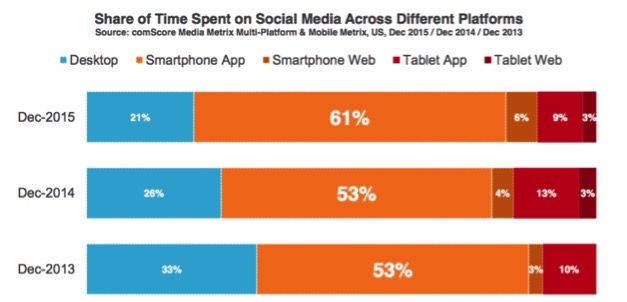
Mobile has become indispensable, just as it was predicted by Mary Meeker in 2008. Perhaps you, too, are reading this post on your mobile device.
The question that arises is: How can B2B marketers take advantage of mobile? The obvious answer is by generating leads, which is by far the biggest challenge in B2B marketing.
For a B2B business, it all begins with a lead. You will have no clients or revenue without leads. In fact, without leads, your business will sink. The other obvious question, therefore, is: How can mobile help you get leads?
Mobile and B2B Lead Generation
The increasing access to smartphones is one of the prime reasons behind the growth of B2B marketing. The astounding data connection capabilities of mobile has boosted lead generation in several ways. For example, the majority of C-suite executives are now using their mobile and smart devices as their primary communication channels. If you, too, are a firm believer of fishing where the fish are, you probably have already adapted to the new mobile reality — as it is becoming increasingly difficult to reach out to decision makers via traditional channels.
In the modern business and workplace scene, people are moving between meetings irrespective of their physical location, thanks to their smartphones. They are browsing their smart devices for information on the go and catching up on work. Perhaps you have already done things such as create a mobile-responsive website, add mobile content that is easy to read and loads quickly, or have a well-defined mobile app to attract the attention of these C-suite executives. But, are you getting enough leads to justify your efforts? If your answer is in the negative, chances are your strategies are lacking the innovative marketing approaches necessary to maximize lead generation.
Having a mobile-responsive website, mobile content and apps will help you survive the mobile tidal wave. But, you need to do more than that to ride it to success. For instance, you need to use effective mobile marketing plans to manage emergency notifications, streamline assignments and handle promotions to enhance B2B effectiveness along with real-time events.
The following four tips will help you maximize your B2B lead generation:
1. Understand Data for Lead Generation
When it comes to lead generation, mobile or otherwise, you need to understand one thing: It doesn’t happen overnight. However, there is something you have at your disposal to power it around the clock: the lead generation data.
It is easy for B2B marketers to drown in data chaos, but with a little structuring and integration, you can successfully navigate your way to helpful data insights.
What type of data do you need to understand purchase behavior? According to a report published by Econsultancy and Signal in June 2015, both B2C and B2B are frequently using the following types of data:
- 87 percent of marketers are using transaction history
- 80 percent of marketers are using customer information
- 74 percent of marketers are using site and campaign behavioral data
- 60 percent of marketers are using customer data from their trusted partners
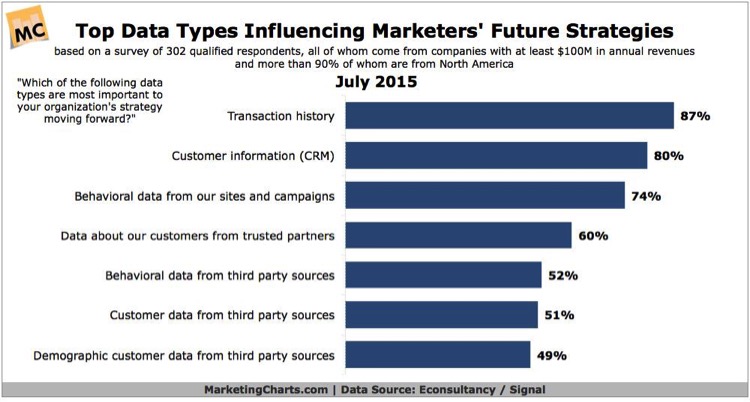
Additionally, a large number (52 percent) of B2B marketers are also using third-party and real-time data information to decode the customers’ purchase behavior. The smartphone’s ability to understand customer behavior has already benefited a large number of marketers. This data combined with geolocation options, constant alerts and real-time services is making mobile marketing an even easier option for most B2B companies. In fact, an increasing number of B2B marketers are combining real-time data and hard-to-find data with first- and third-party data sources to understand their best customers and prospects, based on their past purchase behaviors.
In fact, it also helps marketers to target their prospects when they are actively searching the market for a product. A Social Buying Study from IDC also finds that 75 percent of B2B buyers and 84 percent of C-suite executives “use social media to make purchasing decisions.”
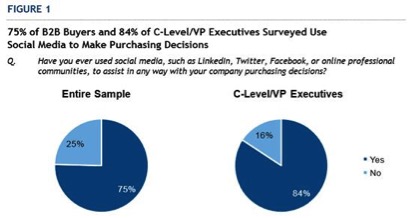
This means prospective buyers are reading reviews, asking for recommendations, and having conversations on social media right now. By using a Data-as-a-Service (DaaS) solutions provider, you not only can monitor the social space for the right keywords and see what people are saying about the products/services you sell, but also contact these prospects in real time with the right offer to help them make a purchase decision.
2. Leverage Rich Media Mobile Display Campaigns
Digital marketers are no strangers to mobile-rich media content. It is basically a digital advertising term used for advertisements that include various advanced features such as audio, video and other elements encouraging viewers to interact with the content. Needless to say, rich media is one of the most engaging forms of digital advertisement.
For B2B marketers, the opportunities are numerous. Create polls, surveys, quizzes, puzzles and/or games to keep people engaged with your mobile display campaign. For example, consider this interactive taco from NYmag.com that allows you to learn more about the taco’s tasty features in an engaging manner as you hover over each ingredient.
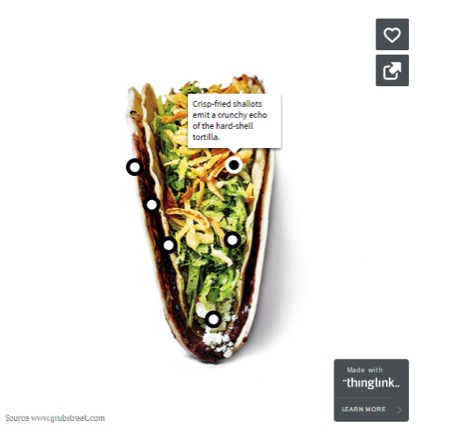
Apart from interactive images, you can also grab customer attention with engaging (short) YouTube videos, lead buyers to your outlets using Google Maps, allow prospective buyers to call you easily via Click-to-Call, provide 360-degree product views to enhance user experience, leverage gyroscope technology (especially for games) for offering a paradigm-shifting ad experience, and so on.
But if you want to start small, here is a creative way to make your mobile emails more engaging and interactive. You can use enterprise-class cloud solutions such as Scratch-It to send engaging messages, using a lottery ticket-like interface. As recipients swipe their mobile screens, it reveals enticing offers or a crisp call to action to grab their attention.
3. Mobilize Your Trade Shows
If you are old-school and still use traditional channels to generate leads, this is definitely for you — with a modern twist. As you are aware, the most effective B2B leads come from in-person connections such as executive events, sales, conferences, telemarketing and tradeshows. In fact, tradeshows and events top the list when it comes to procuring highest-quality leads. Your customers are already at these places; they are already looking for something similar to your product/solution. So take advantage of this proximity with a well-defined mobile strategy.
This can be achieved in two phases. First, the more traditional way is to send text alerts via some incredibly personal and engaging short code texting to remind people of the event. You can even consider sending live-broadcasted text messages during the event in the form of comments, questions and/or poll responses to engage with the audience.
The second phase includes getting more creative with technological innovations. For example, you can allow smartphone holders to participate in real-time events and contests, leverage augmented reality innovations to let potential buyers examine the prospective purchase via mobile video to take the event to the next level. Remember, lead generation and promotion go hand in hand in the B2B industry.
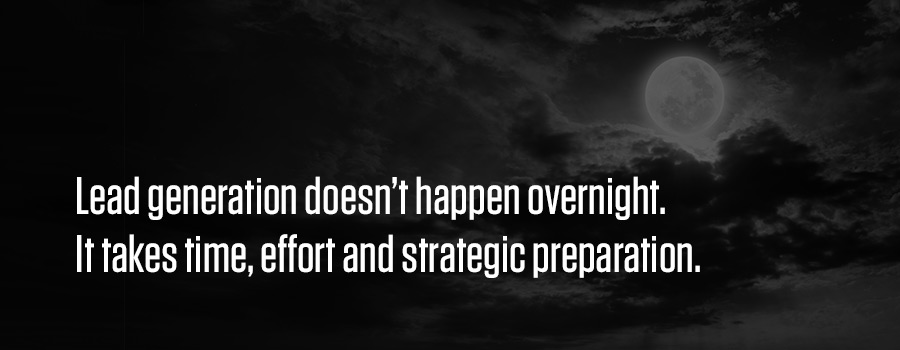
4. Tap on LinkedIn Mobile Features
LinkedIn remains one of the best social spaces for B2B marketers to find prospective buyers, with more than 467 million users. Mobile usage on LinkedIn is something of which you must take note. According to a 2015 report, mobile represents 57 percent of all LinkedIn traffic. Better yet, 50 percent of B2B buyers use this networking site when making purchasing decisions.
Given the reach of LinkedIn, it will be utter foolishness not to leverage this professional networking platform for your next mobile campaign. Start using LinkedIn Sponsored InMail (if you aren’t already) to reach out to prospective audiences. It’s also available via mobile, making it easier for you to test for your business.
As mentioned earlier, lead generation doesn’t happen overnight. It takes time, effort and strategic preparation. Moreover, you need to have correct and specific information on prospects to begin with, and this is where mobile comes in. User data derived from mobile devices is more specific and richer than that collected from desktop cookies. This allows you to better target your campaigns to reach the highly likely candidates.
However, it is also important to remember that lead generation strategies will become dynamic only when new mobile technologies evolve. The best way to stay in the competition is to keep abreast of emerging technologies and trends, and devise your strategies accordingly.
About the Author

Pratik Dholakiya is co-founder of E2M, a full-service digital marketing agency, and Preceptist, a content marketing agency. He regularly speaks at various conferences about SEO, content marketing, growth hacking, entrepreneurship and digital PR. Pratik has spoken at NextBigWhat's UnPluggd, IIT-Bombay, SMX Israel, and other major events across Asia. He has been named one of the top content marketing influencers by Onalytica three years in a row.



